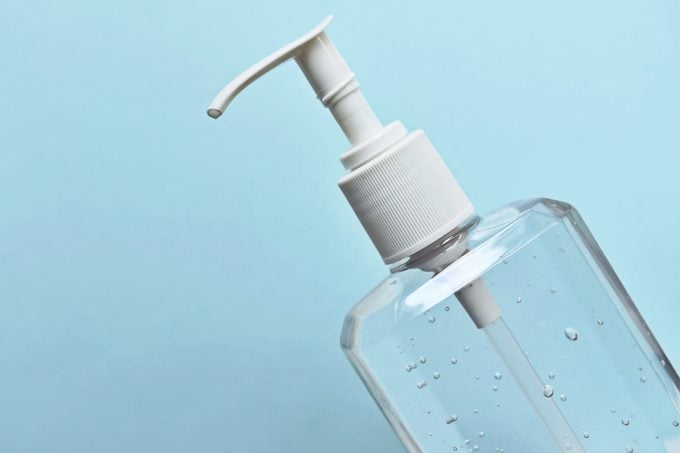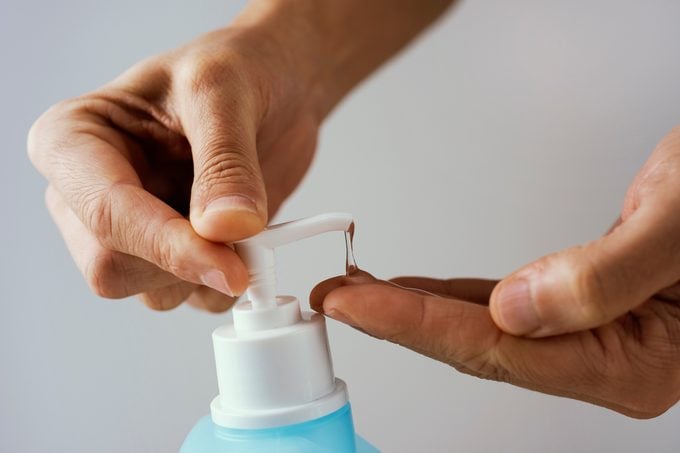How Safe are DIY Hand Sanitizers?
Updated: Apr. 19, 2021
Health experts don't completely agree, but homemade hand sanitizer is probably not your best option for getting rid of germs. Here's why.
Normally, having hand sanitizer “on-hand” is a good thing. When you’re out and about and don’t have access to a sink, the Centers for Disease Control and Prevention (CDC) notes that hand sanitizer containing at least 60 percent alcohol can be used to kill many, but not all, germs that cause illness. This includes cold, flu, and even coronavirus (COVID-19).
But recently, due to the pandemic, shortages of hand sanitizers in stores have led people to turn to all kinds of interesting ingredients for do-it-yourself (DIY) recipes. These range from vodka to rubbing alcohol. But is this a good idea, especially when we are finding some alcohols can be toxic in hand sanitizers?
The CDC hasn’t issued specific guidance on DIY hand sanitizer. So, to find out, we asked health experts who didn’t always share the same view. Take a look at the reasons why you should, or shouldn’t, make your own. It could be one of the “healthy” hygiene habits that are actually bad for you.
Soap and water is always better
First and foremost, the CDC stresses it’s always better to wash your hands than to use hand sanitizer. So if you have access to a sink, soap, and water, that should be your first line of defense against germs including the novel coronavirus COVID-19. According to the CDC, hand sanitizer also doesn’t work if hands are visibly dirty or greasy. “Handwashing with soap and water for 20 seconds is more effective as the ‘friction’ removes more particles,” says Victoria Maizes, MD, executive director of the Andrew Weil Center for Integrative Medicine and professor of clinical medicine, family medicine, and public health at the University of Arizona in Tucson. Just make sure you’re not washing your hands wrong.
 Homemade hand sanitizer is questionable
Homemade hand sanitizer is questionable
Let’s say you’re in a situation for using hand sanitizer—when you are out of your house and don’t have access to soap and water—should you try making your own? “Hand washing is best, but we need to use what we can,” says Suzanne Willard, PhD, an advanced practice nurse and associate dean of global health and clinical professor at Rutgers University School of Nursing in New Brunswick, New Jersey. “It is probably better than nothing.”
Brian Sansoni, a spokesperson for the American Cleaning Institute, takes a different view. “We strongly recommend against trying to make your own hand sanitizer at home,” he says. “Trying to play ‘Mr. Wizard’ at home won’t guarantee that you’ll get the product formulation mix just right.” You should steer clear of the “tricks” to avoid germs that actually don’t work.
What’s the secret to hand sanitizer?
Here’s the issue: You’ve got to make sure your formula has the right proportion of ingredients. “There are many recipes found on the Internet that are essentially the same: Something that cleans such as alcohol, something that makes it less liquid such as aloe vera gel or glycerol, and essential oils to make it smell good,” says Willard. “If you can get the supplies, you can try different recipes to come up with one you like best.”
“Hand sanitizer is a preparation of 60 to 70 ethanol [alcohol] combined with moisturizers,” says Dr. Maizes. “Home recipes often recommend aloe vera gel; if that is hard to find, use glycerol, a common ingredient found in makeup and moisturizers, instead.”
Approved hand sanitizer recipes
There’s a recipe circulating from the World Health Organization (WHO) that was created for areas without access to clean water. However, it’s complex and makes a lot—nearly three gallons); be careful to avoid mistakes if reducing the proportions.
Instead, Dr. Maizes recommends a mixture developed at the Michael Lin Lab at Stanford University. “Mix two parts 95 percent non-denatured ethanol [alcohol] with one part 90 to 100 percent glycerol,” she says. “Use non-denatured ethanol, which lacks toxic additives—that is, avoid bottles with the health hazard [poison] logo.” In addition, she warns, “do not use dehydrated, absolute, anhydrous, 100 percent, or 200-proof ethanol, as that has benzene from the purification process.”
If that sounds complicated, that’s because it is. Basically, you need to use alcohol with some water in it, which is what’s readily available to the public anyway. Your choices are likely rubbing alcohol (isopropyl alcohol) or ethyl alcohol, also called ethanol. The key is to have a high enough content of alcohol in your recipe, 60 percent after you mix it with everything else, to kill the germs: A 2-to-1 ratio.
Skip the vodka
You might have stocked up on booze for your quarantine, but don’t count on your “quarantini” to sanitize your hands. Most vodka contains only 40 percent alcohol (80 proof), so it won’t be strong enough to effectively work. Vodka maker Tito’s confirmed their products can’t be used to make hand sanitizer: “Per the CDC, hand sanitizer needs to contain at least 60 percent alcohol. Tito’s Handmade Vodka is 40 percent alcohol, and therefore does not meet the current recommendation of the CDC,” the company wrote on Twitter.
The “good” side of DIY hand sanitizer
One potential positive to making your own DIY hand sanitizer is that you know what’s in it—giving it an advantage over the unregulated, unlabeled hand sanitizer you might find online or in stores. According to the River Vale Police Department in New Jersey, one boy suffered chemical burns due to hand sanitizer made or doctored by a store owner and then sold. However, details on the case are scarce.
If you’re careful, it could work
It is true that if made properly, a homemade hand sanitizer could kill coronavirus. Plus, it could kill other bacteria and viruses that make you sick. The CDC says that hand sanitizer (again, containing at least 60 percent alcohol) can be used against COVID-19 if soap and water aren’t available. Research such as a 2017 study in The Journal of Infectious Diseases found that hand sanitizer is effective against “enveloped” viruses like coronaviruses, as well as cold and flu. The researchers say the alcohol destroys the bugs by attacking this outer coat. But, hand sanitizer also must be applied properly. You need to cover both sides of the hands and completely rub it in without wiping it off.
Think of the children
A big risk for homemade hand sanitizer is ” if there are young children in the home,” Sansoni says. “You don’t want them to get a hold of that mixture and have them attempt to taste it or play with it.” This is also true with store-bought hand sanitizer; but with homemade, you have even more uncertainty about the strength of the recipe. Plus, the container you use may not be properly labeled or childproofed, adding to the risk of someone drinking it. In addition, Poison Control notes that even inhaling rubbing alcohol can be toxic for kids.
Also, DIY hand sanitizer can harm the skin. There’s a reason hand sanitizer is one of the things dermatologists refuse to use on their hands. Homemade hand sanitizer could ironically make it even more likely you’ll get an infection. How? “Too much alcohol will dry out the skin,” Willard says.
Store-bought products are tested with the proper emollients to help moisturize and soften skin, adds Sansoni. If your DIY recipe is too strong, it could damage your skin, making it cracked or red and increasing your risk that germs can get through, causing an infection, according to the American Academy of Dermatology. The New Jersey Department of Health warns that exposure to rubbing alcohol may cause burns. And while science suggests hand sanitizers are actually less irritating to the skin than soap and water, your homemade hand sanitizer might not have enough moisturizing ingredients to protect your hands.
It doesn’t kill all bugs
Homemade hand sanitizer, though, is subject to the same pitfalls as the store-bought stuff: It doesn’t protect against all germs. The CDC notes that hand sanitizer is not as effective as soap and water against some bugs such as norovirus and Clostridium difficile, also called C. difficile or C. diff, a dangerous bacteria that can cause life-threatening diarrhea. And as we’ve mentioned, if your hands are dirty or greasy, hand sanitizer won’t remove many germs at all. Particularly, if your hands have wet mucus on them—such as if you’ve just sneezed—hand sanitizer might not work. A 2019 study published in mSphere found that alcohol-based rub was ineffective against the flu virus if hands had mucus on them that hadn’t yet dried.
Sheltering in place? You don’t need hand sanitizer
If you’re at home with access to a sink, soap, and water, you won’t miss the gel. “Washing with soap and water is the most important action you can take to help prevent the spread of illness and disease,” Sansoni says. “Any kind of soap fits the bill, so stick with washing your hands with soap and water.” You should be sure to follow proper guidelines for cleaning your hands. This includes after blowing your nose or sneezing, before and after eating, and before and after caring for someone else. Even if you’re not at home, such as if you’re at your workplace, the CDC again recommends hand washing whenever possible. Here are some more compelling reasons why you really need to wash your hands.
On-the-go hand sanitizer for travel
You could consider making your own hand sanitizer if you have to leave the house and don’t have store-bought. “Having a small bottle with you wherever you go is helpful,” Willard says. Or, Sansoni suggests, you could take along hand cleansing wipes if you have them. But, you should also follow additional strategies for preventing the spread of COVID-19 and other diseases. “We should be thinking about where our hands are going—away from the face and mouth—and minimal touching of things that other people are also using,” she says. You’ll want to avoid public places with the most germs. Then, as soon as you get to where you’re going, wash your hands.


